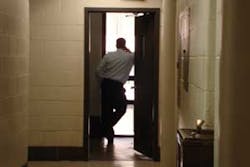Crowds, Cold Challenge D.C. Responders at Inauguration
WASHINGTON, D.C. -- Long before the sun came up over the Nation's Capital Tuesday, hundreds of thousands of people were filling the streets and packing Metro stations.
They had one mission -- to witness the inauguration of the nation's first black president.
D.C. Fire and EMS personnel also were geared up, ready to protect the masses that included the elderly, children and people with special needs. Crews from nearby COG regions answered the call for mutual aid, sending units and people.
They've been swamped with calls. Crews -- that include six EMS task forces -- handled 1,148 responses between 4 a.m. and 4 p.m. Personnel in first aid stations on the Mall treated 490 people, and transported 31.
Sen. Ted Kennedy was taken to Washington Hospital Center after suffering a seizure during the luncheon.
The temperatures -- in the teens overnight -- actually dropped after dawn. Although numerous heating tents were set up across the city, many visitors flagged down EMS crews for assistance.
Officials in the command operations center -- located in Engine 2 -- said there was a crush of calls between 4 and 5 a.m. that stretched local resources because mutual aid crews had not arrived.
People started arriving way before anyone expected. "I heard people were gathering about 1 a.m. That caught us by surprise," said Deputy Chief of Operations Larry Schultz.
He said crowds began forming as early as 1 a.m., but resources were not scheduled to arrive until 6 a.m. Since local units and personnel had not been cleared by Secret Service, they had to stop at check points along the way. Schultz said they had to deal with the delay especially since emergency vehicles have been used in terrorist attacks in other countries.
By 3 a.m., crews were overwhelmed by the masses who were braving the frigid temperatures for a spot. Although there were 40 warming tents set up, and several buildings were open, many suffering from exposure didn't take advantage of the care.
Schultz said people didn't want to leave their prized spots.
By 8:25 a.m., officials said there were more than 400,000 on the Mall. The requests for EMS were continuous. Fire officials said that between the hours of 4 a.m. and 10 a.m., they responded to 262 calls. Those included everything from falls to people with diabetic emergencies, and exposure issues.
EMS crews were busy at the L'Enfant Plaza Metro station when several people required medical assistance after escalators broke down under the weight of the crowd. In addition to several suffering chest pains and difficulty breathing after climbing the stairs, others were complaining of heat issues, officials said.
A woman fell onto a Metro track near Gallery Place, but was not seriously injured.
D.C. Fire Chief Dennis Rubin said a heavy volume of people crowding the city's Metro system had created issues. Eventually, police put a stop to what he called "crushing" pressure at several stations by controlling the number of people allowed inside.
Rubin said D.C. Mayor Adrien Fenty had instructed officials to be prepared for the absolute worst, and so far what crews have experienced has been nowhere near that.
The department prepared for the high volume of calls. There were roughly 200 ambulances stationed in the city, with 80 from D.C. Fire. FEMA supplied nearly 100 ambulances.
"Every call for service has been handled appropriately," Rubin said, adding that in addition to taking care of the visitors, crews have answered calls from their own citizens as well.
It was just as important to keep EMS crews warm as they provided care and watched over the crowds. When they arrived for the briefing Tuesday morning, each was given meals and drinks. Schultz said they had to be self-sufficient once they were in the perimeter.
Getting relief crews in was all but impossible.
At Engine 2, second floor offices were equipped with flat screen televisions which monitored several different news channels. There were also maps stretched across walls, white boards filled with important information, and cameras monitoring local roadways.
In one room, EMS officers kept track of basic and advanced life support ambulances that were stationed in various areas. Calls for service that involved the inaugural event were transferred from emergency communications center to them. Dr. James Augustine, EMS Medical Director, said the crowd made it extremely difficult for an ambulance to get through.
Augustine said he also was keeping track of hospital bed availability.
Ambulance crews from nearby jurisdictions were assigned a navigator who was helping guide them through the city.
Additional ambulance crews that were on standby were called into the city to assist. Schultz said it was fortunate that those units were at the ready.
"The mayor declaring a state of emergency was a brilliant move," he said, because it ensured that fire officials had the resources they needed. Sirens blared as units attempted to weave through crowds. People often ignored the emergency vehicles.
In the command center, officers were keeping tabs on resources, the crowd, traffic and requests for assistance.
Every two hours, all section chiefs gather in an office to report on what's happening. Schultz keeps the meetings short, telling the officers to relay only the pertinent information. Many were operating on little sleep.
Schultz said plans call for the center to stay open until at least 3 a.m. Wednesday.
See Related Training Articles
- Are You Prepared for a Major Catastrophe?
- Introduction to Multi-Company Operations Training
- Crew Resource Management: Communications Under Stress
Drill Downloads
